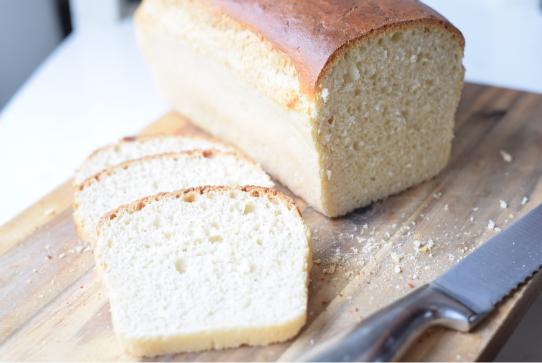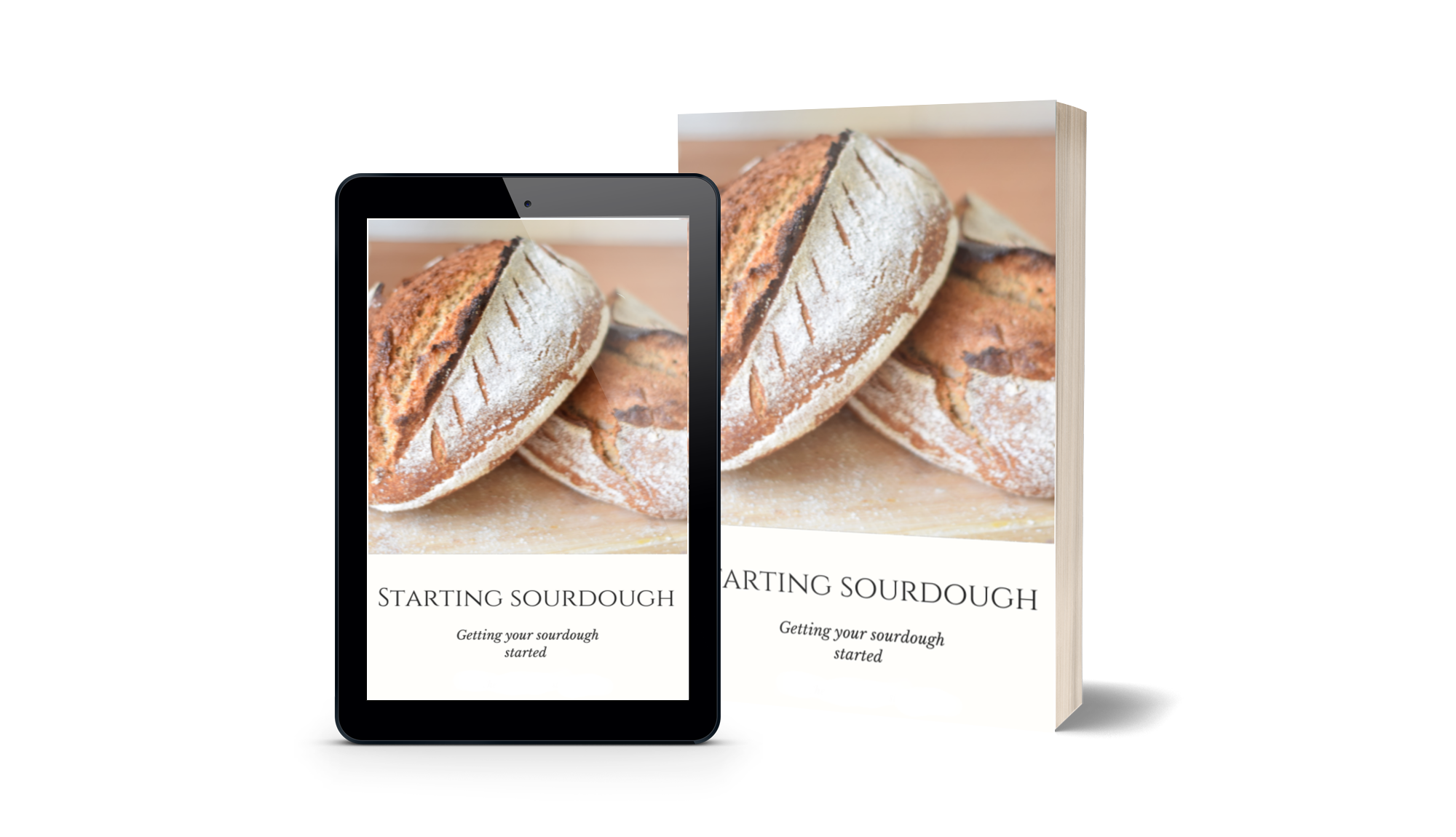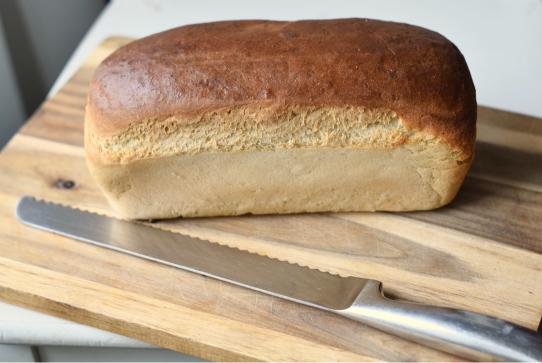Written by: Tahnee Wientjes
There’s nothing quite like the smell of freshly baked, homemade bread. Right? Add some ancient grains to the mix and you’ll have a healthy sandwich bread for lunch. This sandwich bread recipe uses ancient grains like emmer and spelt and is light and airy. It’s the perfect sandwich bread recipe for a spring lunch.
Table of Contents
Sandwich bread with ancient grains
This ancient grain sandwich bread offers several health benefits because it’s made with spelt and emmer. With spelt and emmer as the main ingredients, we’re not just baking bread—we’re nourishing our bodies. Each ancient grain offers its unique blend of nutrients and flavors.
Modern wheat is hybridized so that it yields more. But, with this hybridization, modern-day wheat contains significantly lower numbers of nutrients. I want to encourage you to do your research since so much information has come out in recent years, and it’s not hard to find.
Also, try out my other recipes with ancient grains. They too contain information on ancient grains if you want to learn more about this topic.
In my 10+ years as a homemaker, I’ve come to understand the importance of wholesome ingredients in our recipes. That’s why I encourage you to explore the world of ancient grains. There are several easy, beginner-friendly recipes under the recipes tab here, on the blog.
Whole grains vs. white flour
You can use whole grains and turn this recipe into a whole wheat bread recipe if you prefer. However, the sandwich bread might turn out a little more dense.
You might have to add a little extra water when you use whole grains instead of sifted flour. Let the dough rest for ten minutes after the first knead. The whole grain flour will absorb more water than its non-whole counterparts.
If it’s too dense after the first ten-minute rest add about a tablespoon of water and knead again.
Varieties of flour for sandwich bread
There are many types of ancient grains. Each type has its characteristics, nutritional benefits, and flavors. Amaranth flour, all-purpose einkorn flour, whole grain sorghum flour, hard red wheat, and Khorasan wheat, just to name a few. They will all make this ancient grain sandwich bread a truly flavorful loaf if you want to substitute the emmer or spelt flour.
For some people, sourdough bread is more easily digestible than yeast breads. The fermentation process that happens with sourdough bread, basically pre-digests the bread for you.
If that’s the case for you I share free bread recipes made with sourdough here on the blog, or bundled in my free e-book “Starting Sourdough”.
If you want to make this sandwich bread in a sourdough variety, check out my free e-book Starting Sourdough, and learn how to make your own sourdough starter.
Start baking delicious bread with wholesome and nutritious ancient grains.
Toppings
You can use different toppings for this ancient grain sandwich bread. Think of sunflower seeds, sesame seeds, poppy seeds, flax seed, etc. Or, make a mix of different seeds like brown flaxseed and sesame seeds for a nice color contrast.
You can even coat the ancient grain sandwich loaf with water and sprinkle some steel-cut oats on top to give the sandwich bread a rustic look.
Which loaf pans for sandwich bread
The key to making this ancient sandwich bread a light and slightly fluffy bread is its rise in the loaf pans right after mixing.
While you normally mix and proof the bread, then shape and proof again, this ancient grain sandwich bread requires only one proof.
You can use a bread pan, bread tin, or a parchment paper-lined Dutch oven. Use a little butter or olive oil to grease the sides of the loaf pan.
You can use tapioca flour, brown rice flour, or a little dusting of the emmer and/ or spelt flour to dust the inside of the loaf pan after greasing. This ensures that the sandwich bread comes out easily and it gives the sandwich bread a nice rustic, artisan look.
This recipe makes 1 loaf of bread, but if you have two loaf pans, why not make two while the oven’s hot? Just double the recipe and divide the sandwich bread dough over two loaf pans.

Mixing the dough
The dough is easy to work with and requires just a few simple ingredients. The sandwich bread dough shouldn’t become a sticky dough. It’s supposed to be supple and only slightly tacky.
To make the flour, grind the wheat berries to make your own flour, or use ground flour from the grocery store. I used all-purpose emmer and spelt or a number 680 spelt flour (the higher the number the more sifted. So the finer (and whiter!) the flour).
Combine flour, yearst, and the preferred amount of salt in a medium bowl and combine. Add the water to the flour and yeast mixture and hand-knead or use the dough hook on your stand mixer until the dough is supple and doesn’t stick to your hands.
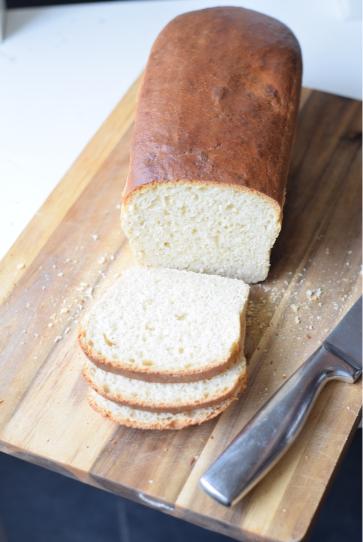
Proofing the dough
The key to getting a nice rise is to have the sandwich bread rise straight in the loaf pan after mixing.
Shape the bread dough by pulling the sides under so you get a firm, smooth dough with good surface tension.
Cover the dough with a towel. You could use plastic wrap, but these reusable bowl covers are a better alternative.
Note: if you want to bake this sandwich bread the next day, stop here. Place the sandwich bread dough in the loaf pan, cover, and place in the fridge. The dough will slowly rise in the fridge. When you’re ready to bake the next day, preheat the oven and bake!
Leave the sandwich bread dough to rise at room temperature until about double in size. Don’t over-ferment the dough! Otherwise, it will rise too much in the oven and the shaggy dough will rise over the sides of the loaf pan.
For some recipes, it’s advised to use warm water or place the mixing bowl with the sandwich bread dough over a pan of boiling water to get it to rise.
I don’t advise doing that with this particular ancient grain sandwich bread recipe since that will likely cause it to rise too fast and drop over the sides of the loaf pan when baked.
Baking the sandwich bread
Preheat the oven to 220°C/428°F. Brush the top of the sandwich bread with milk and sprinkle with toppings like sunflower seeds or sesame seeds. Place the bread dough in the oven and bake for approximately 40 minutes.
The end result will be a golden brown sandwich loaf with a slightly nutty flavor.
In the unlikely case, you end up with leftover bread… :) This sandwich bread recipe is great to use for French toast the next day!
Just whip up an egg or two, add a splash of milk to a large bowl.
Soak the slices of leftover bread in the egg mixture and bake with butter in a large skillet.
Top with fresh fruits and nuts and a generous drizzle of maple syrup. There’s your delicious spring breakfast!
For more “ancient grains creations” like einkorn bread ancient grain rolls and more bread recipes visit my page with ancient grain recipes. Happy baking!
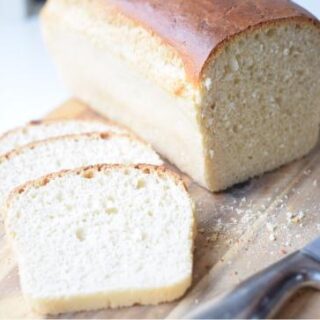
Ancient Grain Sandwich Bread Recipe
This sandwich bread recipe uses ancient grains like emmer and spelt and is light and airy. It's the perfect sandwich bread recipe for a spring lunch.
Ingredients
- 100 grams emmer flour
- 400 grams spelt flour
- 40 grams of butter
- 7 grams of yeast
- 10 grams of sea salt
- 300 ml water
Instructions
- Preheat the oven to 220°C /428°F
- Combine emmer and spelt flour, yeast and salt
- Add water to flour mixture and knead
- Add the butter in small portions. Add another portion when the first is combined in the dough. Keep adding little portions of butter until all is incorporated.
- Knead until the dough is firm and slightly tacky. The dough should be smooth
- Form the dough by folding the sides under while you stretch the dough. This will give the dough a good surface tension.
- Shape and place the dough in the greased loaf pan.
- Cover and proof for approximately one hour. Don't over-proof!
- Brush with milk or water and sprinkle toppings on top (optional)
- Bake for 40 minutes, until golden brown.
Notes
Cool completely before slicing


